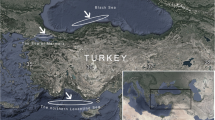Abstract
Acute toxicity of selenium as selenite inZosterisessor ophiocephalus by ip injection was studied. The 50% lethal dose and 50% lethal time were measured to be 0.29 ppm and 96 h, respectively. Se concentrations in liver, gill, skin and muscle, and Cyt. P450 level, Se-GPx, and Total GPx enzyme activities in liver were also assessed at different doses and times after injection. Starting at 0.3 ppm injected dose, enzyme activities and Se concentration in tissues but not in muscle, showed significant differences from the control group. A threshold behavior was inferred. Normal conditions of enzyme activities and Se concentration in tissues were restored about 1 wk after injection. Biological elimination half-lives were about 2 d for liver and gill, and 5 d for skin.
Similar content being viewed by others
References
J. T. Rotruck, A. L. Pope, H. E. Ganther, A. B. Swanson, D. G. Hafeman, and W. G. Hoekstra, Selenium: biochemical role as a component of glutathione peroxidase.Science 179, 588–590 (1973).
P. M. Cumbie and S. L. Van Horn, Selenium accumulation associated with fish mortality and reproductive failure,Proc. A. Conf. S.E. Ass. Fish Wildl. Agencies 32, 612–624 (1978).
R. S. Ogle and A. W. Knight, Effects of elevated foodborne selenium on growth and reproduction of the fathead minnow (Pimephales promelas),Arch. Environ. Contam. Toxicol. 18, 795–803 (1989).
H. M. Ohlendorf, D. J. Hoffman, M. K. Saiki, and T. W. Aldrich, Embryonic mortality and abnormalities of aquatic birds: apparent impacts of selenium from irrigation drainwater,Sci. Total Environ. 52, 49–63 (1986).
P. Kiffney and A. Knight, The toxicity and bioaccumulation of selenate, selenite and seleno-L-methionine in the cyanobacteriumAnabaena flos aquae, Arch. Environ. Contam. Toxicol. 19, 488–495 (1990).
W. J. Adams and H. E. Johnson, Selenium: a hazard assessment and a water quality criterion calculation, inAquatic Toxicology and Hazard Assessment: Fourth Conference, ASTM STP 737, D. R. Branson and K. L. Dickson, eds., American Society for Testing and Materials, pp. 124–137 (1981).
P. V. Hodson, D. J. Spry, and B. R. Blunt, Effect on rainbow trout (Salmo gairdneri) of a chronic exposure to waterborne selenium,Can. J. Fish. Aquat: Sci. 37, 233–240 (1980).
J. W. Hilton, P. V. Hodson, and S. J. Slinger, Absorption, distribution, half-life and possible routes of elimination of dietary selenium in juvenile rainbow trout (Salmo gairdneri),Comp. Biochem. Physiol. 71C, 49–55 (1982).
S. J. Hamilton and K. J. Buhl, Acute toxicity of boron, molybdenum, and selenium to fry of Chinook salmon and Coho salmon,Arch. Environ. Contam. Toxicol. 19, 366–373 (1990).
K. M. Kleinow and A. S. Brooks, Selenium compounds in the fathead minnow (Pimephales promelas) I. Uptake, distribution, and elimination of orally administered selenate, selenite and L-selenomethionine,Comp. Biochem. Physiol. 83C, 61–69 (1986).
K. M. Kleinow and A. S. Brooks, Selenium compounds in the fathead minnow (Pimephales promelas) II. Quantitative approach to gastrointestinal absorption, routes of elimination and influence of dietary pretreatment.Comp. Biochem. Physiol. 83C, 71–76 (1986).
R. W. Estabrook and J. Werringloer, The measurements of difference spectra: application to the cytochrome of microsomes, inMethods in Enzymology, S. Fleisher and L. Packer, eds., Academic, NY, pp. 212–220 (1978).
A. L. Tappel, Glutathione peroxidase and hydroperoxidases, inMethods in Enzymology, S. Fleischer, and L. Packer, eds., pp. 506–517, Academic, New York (1978).
F. Ursini, M. Majorino, M. Valente, L. Ferri, and C. Gregolin, Purification from pig liver of a protein which protects liposomes and biomembranes from peroxidative degradation and exhibits glutathione peroxidase activity on phosphatidilcholine hydroperoxides,Biochem. Biophys. Acta 710, 197–211 (1982).
R. Moro, G. Gialanella, Y. X. Zhang, L. Perrone, and R. Di Toro, Trace elements in full-term neonate hair,J. Trace Elem. Electrolytes Health Dis. 6, 27–31 (1992).
G. P. Buso, P. Colautti, G. Moschini, H. Xusheng, and B. M. Stievano, High sensitivity PIXE determination of selenium in biological samples using a preconcentration technique,Nucl. Instr. Meth. B3, 177–180 (1984).
Author information
Authors and Affiliations
Rights and permissions
About this article
Cite this article
Tallandini, L., Cecchi, R., De Boni, S. et al. Toxic levels of selenium in enzymes and selenium uptake in tissues of a marine fish. Biol Trace Elem Res 51, 97–106 (1996). https://doi.org/10.1007/BF02790152
Issue Date:
DOI: https://doi.org/10.1007/BF02790152




